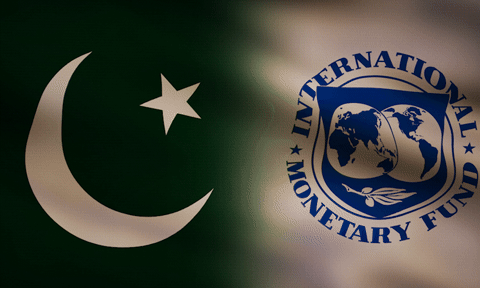Tax-to-GDP ratio in Pakistan is singled out as the principal devil in the fiscal regime of Pakistan and termed as unsustainable. IMF, time and again, highlights it as such and so do the finance managers of the country.
Whereas, to analyse why it is so and to bring forth facts as to how truly the governments deploy the tax collected in public welfare and to spur economic growth in the country is often missed out. The facts and answers lie in grouping together the regime of tax collection and its rightful deployment and then analysing the two together.
Finance Minister Muhammad Aurangzeb while speaking this week at a high-level discussion on the topic of growing burden of global debt on developing economies at the World Economic Forum in Davos, said: “It is difficult to get rid of the debt burden without fixing your own house first.”
The finance minister stated that Pakistan’s biggest issue has been the twin deficits in the current and fiscal accounts. He said the primary reason for the fiscal deficit is the unsustainable tax-to-GDP ratio, which stands at 9 to 10 percent. Efforts are currently underway to increase this ratio to 13 percent, the finance minister added.
That the minister is spot on is a fact. However, tax-to-GDP ratio is one of the factors in the fiscal discipline of the country. There is more to it which needs to be analysed to bring forth the full picture of the fiscal, economic and public welfare structure existing in the country.
Pakistan’s tax revenue as a percentage of GDP is less than 10 percent compared to 18 percent of Azerbaijan’s, 7.8 percent of Bangladesh’s, 13.5 percent of Cambodia’s, 13 percent of Sri Lanka’s and 28 percent and above of mature economies of the West.
Pakistan’s revenue generation capacity has shrunk on account of economic slowdown and more significantly due to the industrial slowdown on account of unsustainable cost of doing business and ease of doing business. Less revenue generation out of economic activities in the country means less means for tax collection.
Pakistan’s expenditure versus GDP is 23 percent compared to 13 percent of Bangladesh’s. Expenditure is biting into the tax collected for gainful purposes.
Pakistanis paid Rs9.4 trillion in taxes. During the same period, government expenditure skyrocketed from Rs2.7 trillion to Rs25 trillion. This needs an explanation.
Pakistan’s debt-to-GDP ratio is 67 percent as compared to 37 percent of Bangladesh’s. More of the taxpayers’ taxes are diverted to debt retirement than being gainfully deployed to support economic growth and public welfare programmes.
Pakistan’s expenditure on education is 1.8 percent of GDP as compared to 4.2 percent in India. This means less talent with taxpaying capacity is being added to the tax regime of Pakistan.
Not surprisingly, on top of this, the GDP recorded a negative growth of - 0.2 percent in 2023 and 2.4 percent in 2024.
Furthermore, the losses emerging out of loss-making public sector enterprises and circular debt retirement are paid off out of taxpayers’ taxes. Another chunk of tax collected for gainful purposes is chopped off.
The government has suffered massive losses: Rs2.8 trillion in buying and selling electricity, Rs1.3 trillion in managing commodities, Rs825 billion and Rs224 billion against PIA’s and Pakistan Steel Mills’ liabilities, respectively. This year alone, grants amounted to Rs1.7 trillion, while subsidies reached Rs1.4 trillion.
Regarding the growth in income and taxpaying capacity of the citizens of Pakistan, the per capita income in the country has shrunk to USD 1587 as compared to USD 2529 in Bangladesh and USD 2,484 in India. In turn, the taxpaying capacity of individuals has shrunk.
These, together with fiscal consolidation and high inflation, led to a poverty rate of 40.5 percent in the fiscal year 2024 and an additional 2.6 million Pakistanis are falling below the poverty line.
Pakistan is categorised as a country with one of highest corporate tax rates on the globe. Reportedly, of all the countries in the world, Comoros at 50 per cent has the highest corporate tax rate in the world while Pakistan’s corporate tax rate goes up till 49 percent. Other examples of countries that have taxed themselves to death include Cote d’Ivoire, Senegal, Zimbabwe, Nigeria, Haiti, Yemen, Mauritania, Uganda, Cameroon and Namibia. They all have unsustainable economies, if not failed economies.
High taxes reduce profitability. Investment is all about profitability and economic and tax growth is all about investment - inland and foreign direct investment.
To fix our own house in order is the right thing to do. But, then all the factors responsible for the mess in the house have to be exposed and fixed. Tax bleeding has to be plugged and economic growth has to be spurred to enhance the taxpaying capacity. Public welfare has to be enhanced to incentivise tax collection.
Fixing tax to GDP ratio is one of the factors and comparably a doable one by taxing the taxed and roping in the new ones in the tax net by all means. Other factors are far more complex and not so easy to lay hands on them. That’s where the challenge and salvation of the nation are embedded.
Copyright Business Recorder, 2025
The writer is a former President of Overseas Investors Chamber of Commerce and Industry (OICCI)

























Comments
Comments are closed.